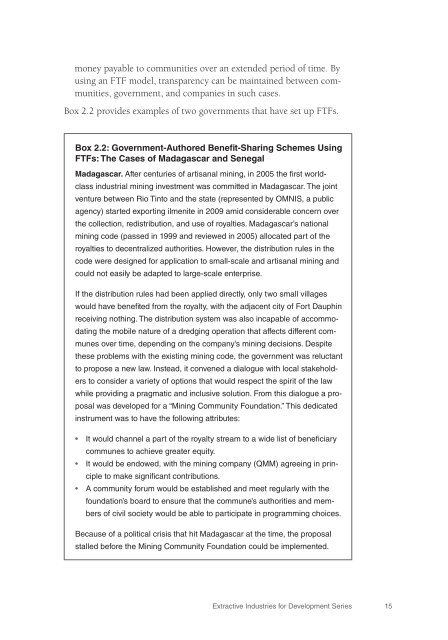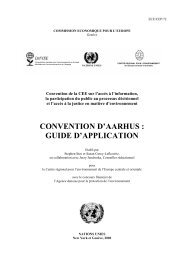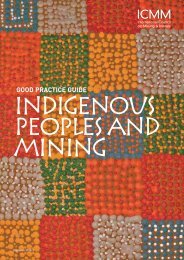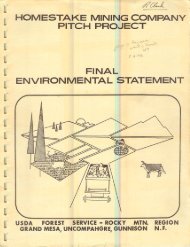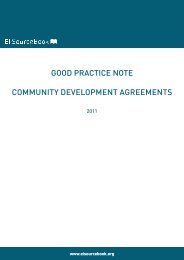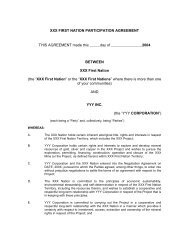Sharing Mining Benefits in Developing Countries - World Bank
Sharing Mining Benefits in Developing Countries - World Bank
Sharing Mining Benefits in Developing Countries - World Bank
You also want an ePaper? Increase the reach of your titles
YUMPU automatically turns print PDFs into web optimized ePapers that Google loves.
money payable to communities over an extended period of time. Byus<strong>in</strong>g an FTF model, transparency can be ma<strong>in</strong>ta<strong>in</strong>ed between communities,government, and companies <strong>in</strong> such cases.Box 2.2 provides examples of two governments that have set up FTFs.Box 2.2: Government-Authored Benefit-<strong>Shar<strong>in</strong>g</strong> Schemes Us<strong>in</strong>gFTFs: The Cases of Madagascar and SenegalMadagascar. After centuries of artisanal m<strong>in</strong><strong>in</strong>g, <strong>in</strong> 2005 the fi rst worldclass<strong>in</strong>dustrial m<strong>in</strong><strong>in</strong>g <strong>in</strong>vestment was committed <strong>in</strong> Madagascar. The jo<strong>in</strong>tventure between Rio T<strong>in</strong>to and the state (represented by OMNIS, a publicagency) started export<strong>in</strong>g ilmenite <strong>in</strong> 2009 amid considerable concern overthe collection, redistribution, and use of royalties. Madagascar’s nationalm<strong>in</strong><strong>in</strong>g code (passed <strong>in</strong> 1999 and reviewed <strong>in</strong> 2005) allocated part of theroyalties to decentralized authorities. However, the distribution rules <strong>in</strong> thecode were designed for application to small-scale and artisanal m<strong>in</strong><strong>in</strong>g andcould not easily be adapted to large-scale enterprise.If the distribution rules had been applied directly, only two small villageswould have benefited from the royalty, with the adjacent city of Fort Dauph<strong>in</strong>receiv<strong>in</strong>g noth<strong>in</strong>g. The distribution system was also <strong>in</strong>capable of accommodat<strong>in</strong>gthe mobile nature of a dredg<strong>in</strong>g operation that affects different communesover time, depend<strong>in</strong>g on the company’s m<strong>in</strong><strong>in</strong>g decisions. Despitethese problems with the exist<strong>in</strong>g m<strong>in</strong><strong>in</strong>g code, the government was reluctantto propose a new law. Instead, it convened a dialogue with local stakeholdersto consider a variety of options that would respect the spirit of the lawwhile provid<strong>in</strong>g a pragmatic and <strong>in</strong>clusive solution. From this dialogue a proposalwas developed for a “<strong>M<strong>in</strong><strong>in</strong>g</strong> Community Foundation.” This dedicated<strong>in</strong>strument was to have the follow<strong>in</strong>g attributes:• It would channel a part of the royalty stream to a wide list of benefi ciarycommunes to achieve greater equity.• It would be endowed, with the m<strong>in</strong><strong>in</strong>g company (QMM) agree<strong>in</strong>g <strong>in</strong> pr<strong>in</strong>cipleto make signifi cant contributions.• A community forum would be established and meet regularly with thefoundation’s board to ensure that the commune’s authorities and membersof civil society would be able to participate <strong>in</strong> programm<strong>in</strong>g choices.Because of a political crisis that hit Madagascar at the time, the proposalstalled before the <strong>M<strong>in</strong><strong>in</strong>g</strong> Community Foundation could be implemented.Extractive Industries for Development Series15


